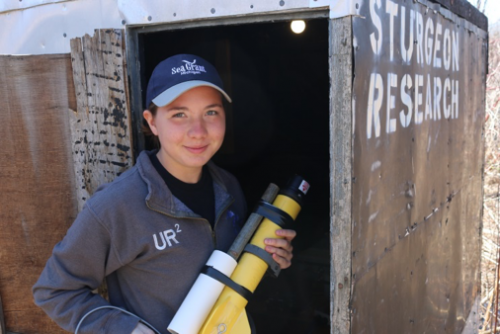Future Spartan already building MSU network through underwater robotics, science career exploration
Alpena High School student assisting sturgeon science team in capturing video, data in the Black River.

High school is a good time to explore career opportunities -- an idea that one Alpena High School student has taken to heart. Liz Thomson soon will be a proud student of Michigan State University. However even before attending MSU, she has combined on-the-job career exploration with networking at the college.
This past year (and upcoming summer), Thomson has worked for Michigan Sea Grant and gained experience that cross-connects her passion for underwater robotics with an interest in future science careers. Along the way she has found many opportunities for fun and to add engaging learning, leadership, and career experiences to her resume.
Dr. Kim Scribner and Doug Larson lead a lake sturgeon research team from MSU Department of Fisheries and Wildlife in collaboration with the Michigan Department of Natural Resources. Supported by the Great Lakes Fishery Trust, they are embarking on a new citizen science project to track movement of spawning sturgeon along with other fish species in the Black River (Cheboygan River Watershed). Thomson is contributing to the project.
The MSU sturgeon science team is installing cameras above the water to capture video of the variety of large fish migrating in the Black River during the springtime sturgeon spawning season. Thomson explored underwater video options and also helped install an underwater camera which will be used help to verify species identification in video data collected during this project. Her project reflects a career exploration opportunity supported by the Michigan Sea Grant and a recently funded Great Lakes NOAA B-WET grant supporting meaningful watershed education experiences for youth across northeast Michigan.
Thomson has fostered her expertise in applying underwater technology toward science through her leadership with the Alpena 4-H Underwater Robotics club and involvement with NOAA Thunder Bay National Marine Sanctuary’s MATE Underwater ROV (remotely operated vehicle) competition.
She has been part of several underwater robotics teams who have built and successfully competed across the state and nation. She also has been involved in a variety of hands-on Great Lakes and natural resource learning experiences in elementary, middle and high school through the Northeast Michigan Great Lakes Stewardship Initiative (NEMIGLSI). The initiative is a regional place-based education network and partnership for which MSU Extension and Michigan Sea Grant provide leadership.
With this new project, Thomson is able to explore careers in Great Lakes and natural resources, and support research design ed to better connect citizens with stewardship of the state-threatened lake sturgeon.
ed to better connect citizens with stewardship of the state-threatened lake sturgeon.
While employed by Michigan Sea Grant, Thomson has supported Great Lakes educational programs in northeast Michigan ranging from fisheries science to youth education projects. “Michigan Sea Grant has given me lots of great connections and networking opportunities from the lake sturgeon project and from the NEMIGLSI network,” Thompson said. ‘Working with the Sea Grant staff has allowed me to develop my skills with data entry and summarizing evaluations and surveys.”
Beyond this in-the-water project, Thomson has been working with a local Sturgeon for Tomorrow Chapter and educators from the NOAA National Marine Fisheries Service to adapt their sturgeon education program for Great Lakes educator audiences. This summer she hopes to pilot some adapted educational activities with teachers – and data collected through this sturgeon citizen science project will be integrated as part of these adapted lessons.
Michigan Sea Grant helps to foster economic growth and protect Michigan’s coastal, Great Lakes resources through education, research and outreach. A collaborative effort of the University of Michigan and Michigan State University and its MSU Extension, Michigan Sea Grant is part of the NOAA-National Sea Grant network of 33 university-based programs.



 Print
Print Email
Email




